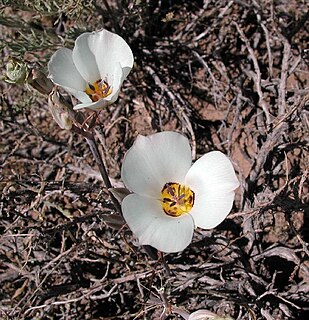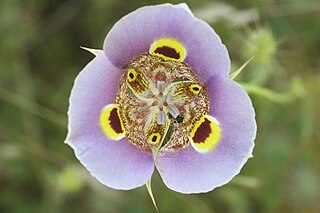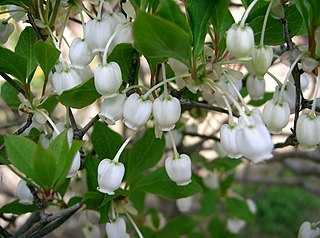
The Dipsacales are an order of flowering plants, included within the asterid group of dicotyledons. In the APG III system of 2009, the order includes only two families, Adoxaceae and a broadly defined Caprifoliaceae. Some well-known members of the Dipsacales order are honeysuckle, elder, viburnum, and valerian.

The flowering plants, also known as angiosperms, Angiospermae, Magnoliophyta, or, more colloquially, flowers, are the most diverse group of land plants, with 64 orders, 416 families, approximately 13,000 known genera and 300,000 known species. Like gymnosperms, angiosperms are seed-producing plants. However, they are distinguished from gymnosperms by characteristics including flowers, endosperm within the seeds, and the production of fruits that contain the seeds. Etymologically, angiosperm means a plant that produces seeds within an enclosure; in other words, a fruiting plant. The term comes from the Greek words angeion and sperma ("seed").

In botany, a bulb is structurally a short stem with fleshy leaves or leaf bases that function as food storage organs during dormancy.

White mustard is an annual plant of the family Brassicaceae. It is sometimes also referred to as Brassica alba or B. hirta. Grown for its seeds, mustard, as fodder crop or as a green manure, it is now widespread worldwide, although it probably originated in the Mediterranean region.

Uvularia sessilifolia, the sessile bellwort, sessileleaf bellwort, little merrybells or wild oats, is a species of bellwort native to eastern and central North America. It grows in woodlands with wet or dry soils.

Blandfordia, commonly known as Christmas bells, is a genus of four species of flowering plants native to eastern Australia. Christmas bells are tufted, perennial herbs with narrow, linear leaves and up to twenty large, drooping, cylindrical or bell-shaped flowers.

Blandfordia punicea, commonly known as Tasmanian Christmas bell, is a species of flowering plant that is endemic to western Tasmania. It is a tufted perennial herb with linear leaves and drooping red, bell-shaped flowers that are yellow on the inside.

Tecoma stans is a species of flowering perennial shrub in the trumpet vine family, Bignoniaceae, that is native to the Americas. Common names include yellow trumpetbush, yellow bells, yellow elder, ginger-thomas. Tecoma stans is the official flower of the United States Virgin Islands and the floral emblem of The Bahamas.

Digitalis grandiflora, the yellow foxglove, big-flowered foxglove, or large yellow foxglove, is a species of flowering plant in the genus Digitalis, family Plantaginaceae. It is native to southern Europe and Asia. In mountains it grows on warm, bushy slopes or areas left after logging.

Blandfordia grandiflora, commonly known as Christmas bells is a flowering plant endemic to eastern Australia. It is a tufted, perennial herb with narrow, channelled, linear leaves and between two and twenty large, drooping, bell-shaped flowers. The flowers are red with yellow tips or sometimes entirely yellow. It is one of four species of Blandfordia known as Christmas bells, this one growing on the coast and ranges between Sydney in New South Wales and Fraser Island in Queensland.

Calochortus bruneaunis is a species of flowering plant in the lily family, and is known by the common name Bruneau mariposa lily.
Calochortus concolor, also known by the common name goldenbowl mariposa lily, is a species of flowering plant in the lily family.

Calochortus monophyllus is a North American species of flowering plants in the lily family known by the common name yellow star-tulip.

Calochortus superbus is a North American species of flowering plants in the lily family known by the common name superb mariposa lily. It is endemic to California, a common member of the flora in several types of habitat across much of the state. It is most abundant in the Coast Ranges and in the Foothills of the Sierra Nevada.

Prosartes, the fairybells, is a North American genus of flowering plants in the lily family.

Rosa 'Arthur Bell',, is a yellow rose cultivar, bred by Sam McGredy IV in Northern Ireland in 1956. The rose has won numerous awards, and is popular in England and Northern Europe.

Enkianthus perulatus (dodan-tsutsuji) is a species of flowering plant in the family Ericaceae, native to Japan. It is a compact, slow-growing, deciduous shrub eventually growing to 2 m tall and wide. Pendent umbels of pure white, bell-shaped flowers in spring are followed in autumn by brilliant red and yellow leaf colours.

Allium flavum, the small yellow onion or yellow-flowered garlic, is a species of flowering plant in the genus Allium, which also includes the flowering and culinary onions and garlic. A bulbous herbaceous perennial, it is native to the lands surrounding the Mediterranean, Black, and Caspian Seas, from France + Morocco to Iran + Kazakhstan.
Fritillaria chitralensis is a species of flowering plant in the lily family, native to and Afghanistan and to the Chitral District of northern Pakistan.

Blandfordia cunninghamii is one of four species of flowering plant commonly known as Christmas bells. It is a tufted, perennial herb endemic to the Blue Mountains and Illawarra regions of eastern Australia. It has long, narrow, linear leaves and between twelve and thirty large, drooping, cylindrical to bell-shaped red flowers with yellow tips.

















